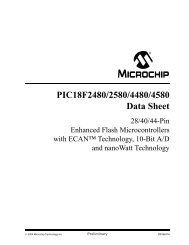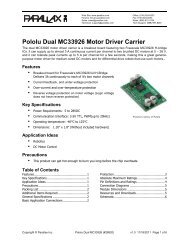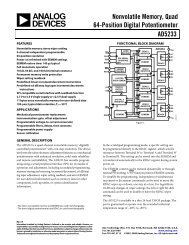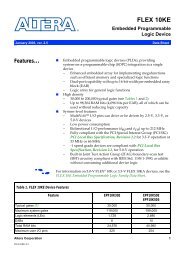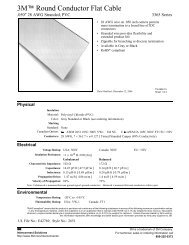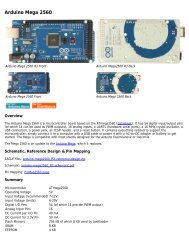ATmega48PA/88PA/168PA/328P Datasheet ... - Atmel Corporation
ATmega48PA/88PA/168PA/328P Datasheet ... - Atmel Corporation
ATmega48PA/88PA/168PA/328P Datasheet ... - Atmel Corporation
Create successful ePaper yourself
Turn your PDF publications into a flip-book with our unique Google optimized e-Paper software.
<strong>ATmega48PA</strong>/<strong>88PA</strong>/<strong>168PA</strong>/<strong>328P</strong><br />
architecture is more code efficient while achieving throughputs up to ten times faster than conventional<br />
CISC microcontrollers.<br />
The <strong>ATmega48PA</strong>/<strong>88PA</strong>/<strong>168PA</strong>/<strong>328P</strong> provides the following features: 4/8/16/32K bytes of In-<br />
System Programmable Flash with Read-While-Write capabilities, 256/512/512/1K bytes<br />
EEPROM, 512/1K/1K/2K bytes SRAM, 23 general purpose I/O lines, 32 general purpose working<br />
registers, three flexible Timer/Counters with compare modes, internal and external<br />
interrupts, a serial programmable USART, a byte-oriented 2-wire Serial Interface, an SPI serial<br />
port, a 6-channel 10-bit ADC (8 channels in TQFP and QFN/MLF packages), a programmable<br />
Watchdog Timer with internal Oscillator, and five software selectable power saving modes. The<br />
Idle mode stops the CPU while allowing the SRAM, Timer/Counters, USART, 2-wire Serial Interface,<br />
SPI port, and interrupt system to continue functioning. The Power-down mode saves the<br />
register contents but freezes the Oscillator, disabling all other chip functions until the next interrupt<br />
or hardware reset. In Power-save mode, the asynchronous timer continues to run, allowing<br />
the user to maintain a timer base while the rest of the device is sleeping. The ADC Noise Reduction<br />
mode stops the CPU and all I/O modules except asynchronous timer and ADC, to minimize<br />
switching noise during ADC conversions. In Standby mode, the crystal/resonator Oscillator is<br />
running while the rest of the device is sleeping. This allows very fast start-up combined with low<br />
power consumption.<br />
The device is manufactured using <strong>Atmel</strong>’s high density non-volatile memory technology. The<br />
On-chip ISP Flash allows the program memory to be reprogrammed In-System through an SPI<br />
serial interface, by a conventional non-volatile memory programmer, or by an On-chip Boot program<br />
running on the AVR core. The Boot program can use any interface to download the<br />
application program in the Application Flash memory. Software in the Boot Flash section will<br />
continue to run while the Application Flash section is updated, providing true Read-While-Write<br />
operation. By combining an 8-bit RISC CPU with In-System Self-Programmable Flash on a<br />
monolithic chip, the <strong>Atmel</strong> <strong>ATmega48PA</strong>/<strong>88PA</strong>/<strong>168PA</strong>/<strong>328P</strong> is a powerful microcontroller that<br />
provides a highly flexible and cost effective solution to many embedded control applications.<br />
The <strong>ATmega48PA</strong>/<strong>88PA</strong>/<strong>168PA</strong>/<strong>328P</strong> AVR is supported with a full suite of program and system<br />
development tools including: C Compilers, Macro Assemblers, Program Debugger/Simulators,<br />
In-Circuit Emulators, and Evaluation kits.<br />
2.2 Comparison Between <strong>ATmega48PA</strong>, ATmega<strong>88PA</strong>, ATmega<strong>168PA</strong> and ATmega<strong>328P</strong><br />
The <strong>ATmega48PA</strong>, ATmega<strong>88PA</strong>, ATmega<strong>168PA</strong> and ATmega<strong>328P</strong> differ only in memory<br />
sizes, boot loader support, and interrupt vector sizes. Table 2-1 summarizes the different memory<br />
and interrupt vector sizes for the three devices.<br />
Table 2-1.<br />
Memory Size Summary<br />
Device Flash EEPROM RAM Interrupt Vector Size<br />
<strong>ATmega48PA</strong> 4K Bytes 256 Bytes 512 Bytes 1 instruction word/vector<br />
ATmega<strong>88PA</strong> 8K Bytes 512 Bytes 1K Bytes 1 instruction word/vector<br />
ATmega<strong>168PA</strong> 16K Bytes 512 Bytes 1K Bytes 2 instruction words/vector<br />
ATmega<strong>328P</strong> 32K Bytes 1K Bytes 2K Bytes 2 instruction words/vector<br />
ATmega<strong>88PA</strong>, ATmega<strong>168PA</strong> and ATmega<strong>328P</strong> support a real Read-While-Write Self-Programming<br />
mechanism. There is a separate Boot Loader Section, and the SPM instruction can<br />
only execute from there. In <strong>ATmega48PA</strong>, there is no Read-While-Write support and no separate<br />
Boot Loader Section. The SPM instruction can execute from the entire Flash.<br />
8161DS–AVR–10/09<br />
6





